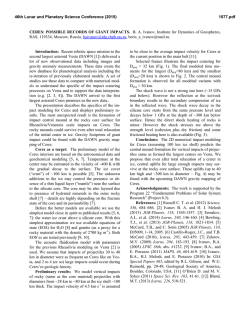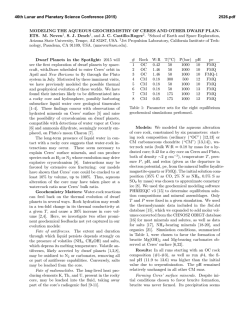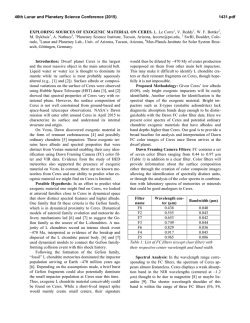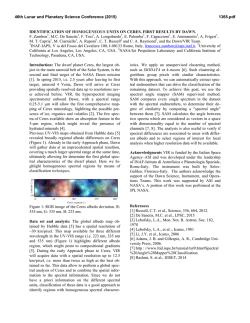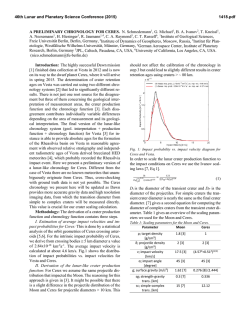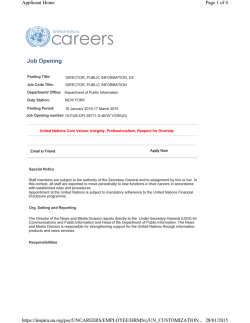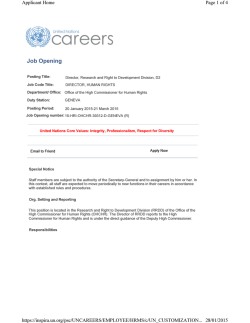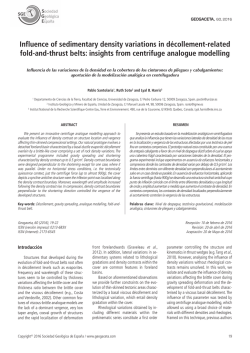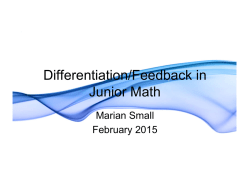
CERES AND CHARON: PREDICTIONS FOR CHEMICAL
46th Lunar and Planetary Science Conference (2015) 2664.pdf CERES AND CHARON: PREDICTIONS FOR CHEMICAL COMPOSITION, PHYSICAL STRUCTURE AND ORIGIN. A. J. R. Prentice1,2, 1MOCA, Monash University, Victoria 3800, Australia; 2Astrophysics Group, University of Southern Queensland, Toowoomba, Queensland 4350, Australia ([email protected]). Introduction: The impending arrival of the Dawn spacecraft at Ceres in March 2015 and the encounter of New Horizons with the Pluto-Charon system in July have awakened fresh interest in the origin of these icy bodies of our Solar System. Ceres is unusual because its low mean density ∼2.08 g/cm3 implies a water ice mass fraction ∼0.25 [1]. How did Ceres acquire so much water given that the ‘snow-line’, according to most models of the solar nebula, lies near ∼5 AU? The Pluto-Charon system is characterized by a large separation in the mean densities of these 2 bodies. This suggests a different mode of origin for each. One possibility is that Charon, together with the 4 moonlets of Pluto lying beyond Charon, formed by the rotational fission of the liquid mantle of a once rapidly spinning protoPluto [2–5]. Charon coalesced from the bulk of the ejected liquid mantle and Pluto formed from the solid rock core and liquid left behind. A major obstacle for this model, however, is that the observed Charon mean density ∼1.63 g/cm3 [6] greatly exceeds that of H2O ice. In this paper I examine the formation of Ceres and Charon within the framework of the modern Laplacian model of Solar System origin (hereafter MLT) [7–9]. The Modern Laplacian Theory: The MLT is a quantification of the nebula model of Laplace [10]. It is proposed that the planetary system condensed from a concentric family of orbiting gas rings. These rings are shed by the contracting protosolar cloud (PSC), close to the present planetary orbits. The process of shedding discrete rings, rather than a disk, comes about through the existence of a powerful radial turbulent stress pturb arising from supersonic thermal convection within the cloud. If ρ(r) and T(r) denote the density and temperature at radius r, then for a non-rotating adiabatic cloud pturb = β0ρGM(r)/r, where M(r) is the mass interior to radius r and β0 is the turbulence parameter. The total pressure at each point is ptot = pturb + pgas, where pgas = ρℜT/µ is the gas pressure, T is the temperature and µ is the mean molecular weight. As convective motion ceases at the cloud photosurface (radius rs), the outer layer of the PSC is strongly superadiabatic. It has an assumed polytropic index n0 = -1. The base of the outer layer is defined by a parameter F0 = µsT0/µ0Ts. The photosurface of the PSC is defined by the parameter θs = µcTs/µsTc, where c refers to the centre and Ts is the surface temperature. Rotation is included using the atmospheric approximation [7]. The ratio Pt = pturb/pgas achieves it maximum value ∼5–10 at the base of the superadiabatic outer layer and is 0 at the surface. If the controlling parameters β0, F0 and θs stay constant during gravitational contraction, the PSC sheds a system of gas rings whose initial orbital radii Rn,i (n = 1, 2, 3...) form a nearly geometric sequence. We assume that the KBOs condensed from the first shed gas ring and set R0 equal to Quaoar’s mean distance, viz. 43.2 AU. The initial mass M0 of the PSC is chosen so the final cloud mass equals the solar mass MSun. For any given β0, the parameters θs and F0 are chosen so that (i) the mean orbital spacing of the rings from Jupiter to Mercury matches the observed mean geometric spacings of the planets, including Ceres, and (ii) that the metal mass fraction of the condensate at Mercury’s orbit leads to a planetary model whose mean density matches the observed value, namely 5.432 g/cm3 [9, 11]. The elemental abundances of the PSC are taken from ref. [12] for the chondritic elements and ref. [13] for C, N and O. The parameter β0 has control over the water content of the condensate at the orbit of Jupiter. Choosing β0 = 0.1135, F0 = 9.0734 and θs = 0.002323 gives a Mercurian core of mass fraction Xmetal = 0.7096 and a water ice content for the Jovian ring condensate Xice = 0.490. The initial PSC mass is 1.215MSun. Properties of the Proto-Solar Gas Rings: The table below gives the basic properties of the gas rings from which each of the listed planets condensed. Because the PSC loses mass during contraction, the initial mean orbital radii Rn,i at the moment of detachment from the cloud equator are smaller than the present values Rn, which are shown. We have Rn = (Mn/M⊙)Rn,i, where Mn is the PSC mass after detachment of the n-th ring. The pressure on the mean orbit of gas ring is pn. Planet Mercury Earth Ceres Jupiter Quaoar Rn/AU 0.387 1.000 2.767 5.203 43.18 Tn/K 1628 679 272 158 26.3 pn/bar 0.181 5.0×10-3 8.9×10-5 6.5×10-6 1.3×10-9 Xmetal 0.7096 0.2567 0.0091 0.0077 0.0084 XH2O 0.0000 0.0015 0.0418 0.4901 0.1854 The Predicted Bulk Chemical Compositions: The diagram below describes the chemical condensation for the system of gas rings cast off by the PSC in the inner Solar System. The heavy yellow locus gives the local temperature at the equator of the PSC and the open circles give the temperatures Tn of the gas rings. Also plotted are the equilibrium condensation tempera- 46th Lunar and Planetary Science Conference (2015) tures of the principal chemical species. These are computed for the gas pressure pn on the mean orbit of each ring. Mercury is metal-rich as most of the silicates remain as vapour. This metal-silicate fractionation mechanism was first quantified by Lewis for the solar nebula [14]. We note that the rock constituent is also enhanced in its Th and U content, by a factor of ∼5, because of the same fractionation process. Results for Ceres: At Ceres’ orbit the principal chemical components of the condensate are MgSiO3–Mg2SiO4 (mass fraction 0.228), magnetite (0.181), (Fe–Ni–Co)S (0.191), SiO2 (0.166), brucite (0.127), akermanite (0.041), spinel (0.030) and NaOH–KOH (0.011). Assume now that short-lived radionuclides cause a complete dehydration of the rock and separation of the rocks and metals. A planetoid with this mix has a metal sulphide core (mass fraction 0.19995; RTP density 4.960 g/cm3), surrounded by a salt-free rocky layer (0.75670; 3.430 g/cm3) and a liquid water mantle (0.04182) with dissolved NaCl (0.00153). As Tn just exceeds the brine freezing temperature, the mantle remains liquid. Unfortunately, the water mass is much too small to produce a Ceres of density ∼2.08 g/cm3. If, however, all of the MB asteroids started out as watery embryos, then collisions between neighbours would favour the transfer of water from smaller to larger bodies, because of gravity. Also, as long as the planetesimal stream remained closely confined to the mean orbit Rn, any dislodged water may later be accreted by the largest asteroid: Ceres! A present-day thermally-evolved structural model for Ceres has been constructed on the basis that the initial planet acquired a mass of water and dissolved salt equal to ∼8.08 times its initial store. Rotation is not included. The model has radius 476.2 km [1] and surface temperature 160 K. The central temperature is 195 K. The metal core has mass fraction 0.153 and radius 190 km. The outer mantle of mass fraction 0.268 has a 2664.pdf salt layer ∼2.5 km thick at the base of a pure H2O ice shell of radius 119 km. The axial MOI factor is 0.295. This value increases to 0.303 if metal sulphide has not separated from the rock. Dawn should find the surface of Ceres to be very flat on average, but fissured though the expansional freezing of its primordial ocean and roughened through aeons of impact cratering. Results for Charon: Lastly, I consider the origin of Charon in the context of the rotational fission model. It is assumed that Pluto initially condensed as a KBO at the same orbital distance as Quaoar. The condensate consists of nearlydry rock (mass fraction 0.5256), graphite (0.0163), H2O ice (0.1840), CO2 ice (0.2206) and CH4 ice (0.0535). The mean density of this mix is 1.725 g/cm3. Assume now that the proto-Pluto underwent total differentiation due to the decay of short-lived radio nuclides and that its initial store of CH4 escaped. The new mass fractions of the liquid mantle are CO2 (0.5433) and H2O (0.4567). I ignore dissolved NaCl. A 2-zone model for Charon having radius 606 km [6] has been constructed for this mix, assuming a uniform temperature 40 K. The mean density 1.46 g/cm3 for this model falls a long way short of the observed value. To obtain this value requires a CO2 mass fraction ∼0.85. This can be achieved if the O atom number in the PSC is reduced by 15%. Such a change is consistent with the uncertainty in the measured solar elemental abundance of O [12, 13]. I predict that the New Horizons spacecraft will discover Charon and the other moons of Pluto to be balls of pure ice. Their surfaces should be very flat and smooth and consist solely of water ice. No fissuring is expected. Pluto’s surface should be similar. Acknowledgements: I thank George W. Null for much support and encouragement over many years. I thank Steven Morton and Allan Thorne for exceptional technical support at Monash University. References: [1] Thomas P. C. et al. (2005) Nature, 437, 224–226. [2] Mignard F. (1981) Astron. Astrophys. 96, L1–L2. [3] Lin D. N. C. (1981) MNRAS, 197, 1081–1085. [4] Prentice A. J. R. (1993) BAAS, 25 1181 [5] Prentice A. J. R. (1993) Australian J. Astron., 5, 111–119. [6] Person M. J. et al. (2006) ApJ, 132, 1575–80. [7] Prentice A. J. R. (1978) Moon Planets, 19, 341–398. [8] Prentice A. J. R. (2006) PASA, 23, 1– 11. [9] Prentice A. J. R. (2008) LPS XXXIX, Abstract #1945. [10] Laplace P. S. de (1796) Exposition du Systeme du Monde, Courcier, Paris, 387–397. [11] Smith D. E. et al. (2012) Sci., 336, 214–217. [12] Lodders K. et al, (2009) Landolt-Bornstein, New Series, Vol. VI/4B, Chap. 4.4, 560–630. [13] Caffau E. et al. (2010) A&A, 514, A92, 1-11. [14] Lewis J.S. (1972) Earth & Planet. Sci. Letts., 15, 286–290.
© Copyright 2026
